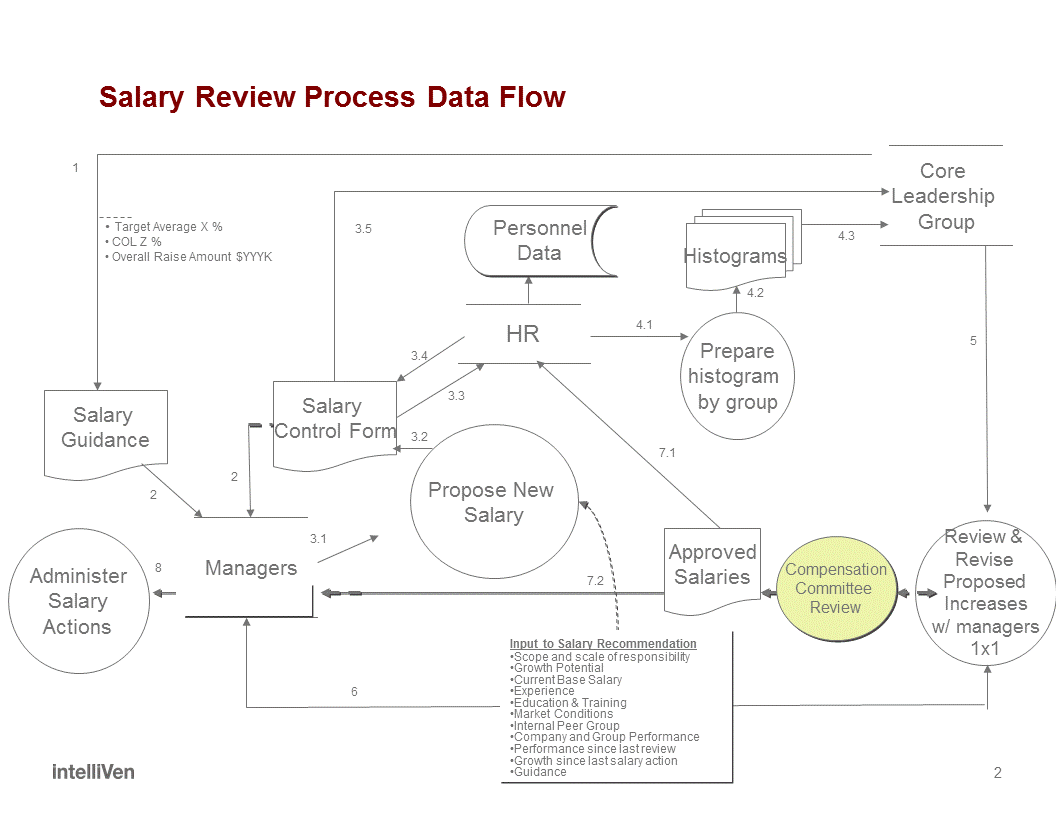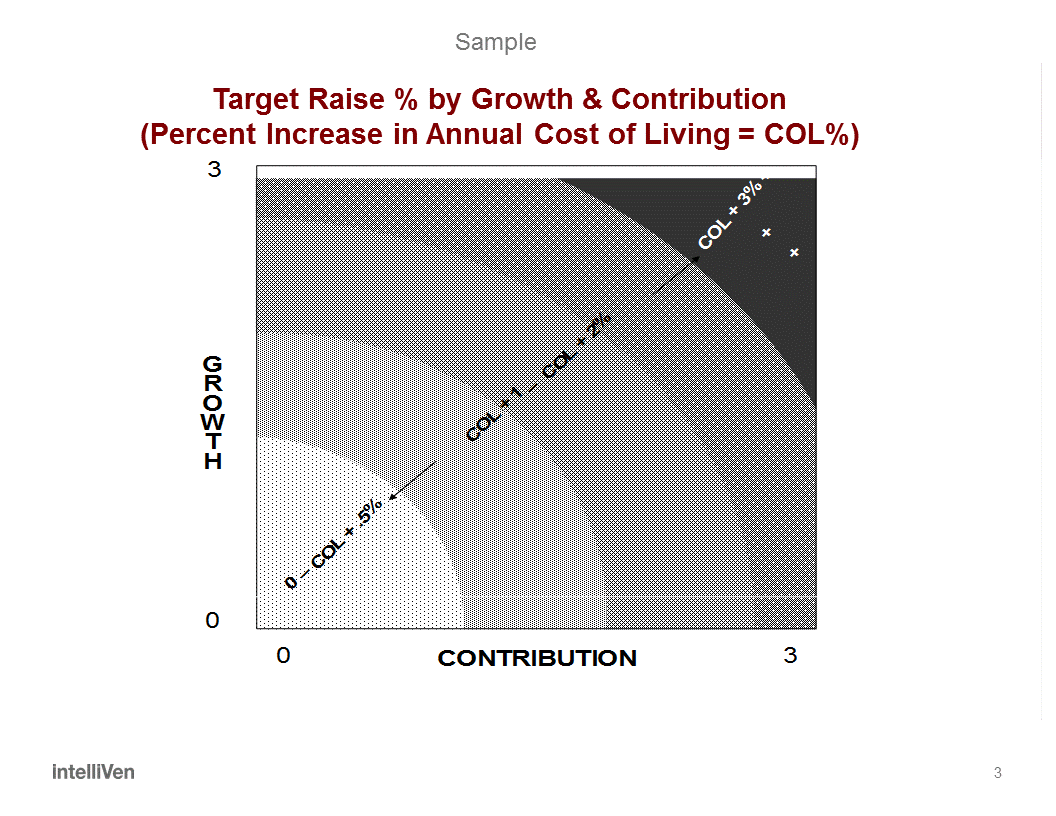Labor costs are the largest expense for many organizations and so should be carefully and responsibly managed; every salary action should be taken seriously. Nothing affects organization culture more than how people are paid.
Less experienced managers and leaders may use salary actions as a way to keep staff happy thinking, perhaps, that they are doing someone a favor or following an easier path. It turns out, though, that the easy way out can leave employees confused, just as dissatisfied, and questioning management motives and decisions.

A good strategy is to use salary actions to communicate important information to employees and to help supervisors and unit managers become better leaders. It takes significant time and effort to design, develop, implement, and institutionalize an effective salary administration process (see Figure 1) but is well worth it. This post presents steps responsible leaders can take to administer a fair and rational salary action process (see Figure 2).

Annual salary actions, such as a raise in base pay, are generally processed soon after (but not at the same time as) managers complete and administer their appraisal of employee growth and performance.
Organizations that seek themselves to perform and grow are wise to encourage performance and growth in every employee by tying salary actions primarily to how employees have performed and grown relative to (i.e., below, at, or above) expectations over a performance period.
Guidance, such as the following, is prepared by Core Leaders and distributed by Human Resource staff to supervisors and unit leaders to launch the process:
- Cost-of-living basis: the level at which an increase in salary effectively keeps an employee at a constant pay rate relative to the market in which they work.
- Target average annualized percent increase: the average percentage increase in an employee’s pay that is consistent with organization performance relative to peers and market conditions. For example, in a market where salaries for organizations that are similar in terms of skills, performance, scale, and sources of new-hires have increased 6%, an organization that is performing reasonably well might target their average increase to hover around that same 6% mark.
- Ceiling for sum of all raises: the total increase in labor costs management is comfortable absorbing from a round of salary actions based on organization performance, scale, growth prospects, and market conditions. For example, an organization that is performing well with a 200 people, half of whom are on the current salary action cycle, with an annual average salary of $95,000 might set an overall ceiling to increase unloaded monthly salaries by:
Increase in labor costs due to salary actions =
(200/2 people getting raises * 6% average raise * $95,000 current annual base rate of pay) / 12 months = $47,500/month.

Managers fill out a salary action control form (see Figure 3) to log and submit recommended raises, normalized for time at the current level of compensation (aka: annualized; see example below), for each person on the current Salary Action cycle based on:
- Performance expectations calibrated for relevant education, training, experience, and compensation; i.e., more job-specific education, training, and experience generally means higher pay but also higher performance expectations; and
- Actual performance since last salary action.
- Growth since last salary action; a sustained level of performance at a higher level, vs. a short-term spike in performance followed by a return to previous level, may put a person into the entry level of compensation for the next higher category of performance.
- Scope and scale of responsibility; the more a person is responsible for, the more compensation they generally deserve.
- Growth potential; it makes sense to pay employees with extraordinary potential, especially in a hot job market, at higher levels in order to increase the odds that their potential is actualized in the current organization rather than elsewhere…as long as steps to cultivate the potential are taken.
- Internal peer group; compare pay for employees in the same job and in the same organization to ensure their relative compensation is rational; e.g., the best at what those in a given peer group do should probably be paid more than the others.
- Market conditions: compare pay for employees in the same job, in different organizations, and in the same market to ensure compensation is rational; an organization, for example, might target to compensate at the 75th percentile of market.
- Organization and group performance; if a unit or the organization performs well, higher salary increases for those responsible are justified. If an organization or unit performs poorly then it would be surprising if many in that group deserve significant increases in compensation and the average increases for the unit as a whole would likely be below the targeted overall average.
The Core Leadership Group reviews recommended salary actions in aggregate and by performance unit (e.g., client or market) and functional peer group (e.g., program managers, engineers, business analysts, sales, etc.) relative to overall guidance and to verify that:
- Highest increases are going to those who have contributed and grown the most.

Figure – 4 Salary Action Histogram - Lowest increases are going to those who have contributed and grown the least.
- Those paid the most contribute the most.
- Those paid the least contribute the least.
- The distribution of increases (as depicted, for example, in Figure 4) is rational relative to group performance; e.g., the average raise for a group that performs poorly should be below the overall average.
Core Leaders review one-on-one with each manager to discuss actions and to make refinements that are final subject to approval by compensation committee of the board.
Example Annual Salary Review Guidance
- Cost of Living Basis: 3.0%
- Target average increase 5.50%
- Overall ceiling to annual salaries: $285,000

Examples that show how to use performance and growth appraisal scores to determine recommended annualized base salary increases (see Figure 5):
- The annualized increase in base salary for an employee with a [performance, growth] appraisal score of [2,2] should be in the 3 % range.
- The annualized increase for an employee with an appraisal score of [3, 2] should be in the 4 % – 5 % range.
- The annualized increase for an employee with an appraisal score of [3,3] might be 6% or greater.
- Employees performing below expectations, or performing well but with a current salary above market (i.e. a suitable replacement could be hired at a lower salary) should receive an increase below the cost of living.
Notes
- Raises must be earned and not automatic even when cost of living increases significantly. Those who do not perform or grow have no right to automatic increases just for sticking around.
- True increases in performance level (vs. a temporary spike in performance) may require an adjustment to base salary prior to raise award. Adjustments can be removed from the average raise calculation but only if they are significant and rare, so as not to be used to artificially hold down the average raise percent.
- Percentage increases should be normalized for time at current salary such that a $1200 raise for an employee who has not had a salary action in 13 months is getting less of a raise than someone who also gets a $1200 raise and last had a salary adjustment ten months ago. The formula for normalizing increases for time since last action is:
Annualized Increase % =
((raise amount / old base) / (months at old base / 12))
Three equal raise amounts normalize to different annual percentage increases according to how long it has been since last salary action:
|
old base |
months since last action |
raise amount |
new base |
annualized increase % |
|
$90,000 |
12 |
$9,000 | $102,000 |
10.00% |
|
$90,000 |
13 |
$9,000 | $102,000 |
9.23% |
|
$90,000 |
9 |
$9,000 | $102,000 |
13.33% |
- Salary actions are generally taken annually. Running the process for the entire employee population at one time can be overwhelming so many organizations divide staff into two groups such that salary actions for each group are taken annually six months apart.
- Some organizations run a continuous salary action process in order to award increases on the anniversary of hire. With any scale, this means processing salary actions every month of the year which takes a great deal of continuous effort. Important steps may be short-circuited and/or the process may become an ongoing diversion from that which the organization might otherwise be doing to perform and grow.
- All senior staff should be on the same salary action cycle.
